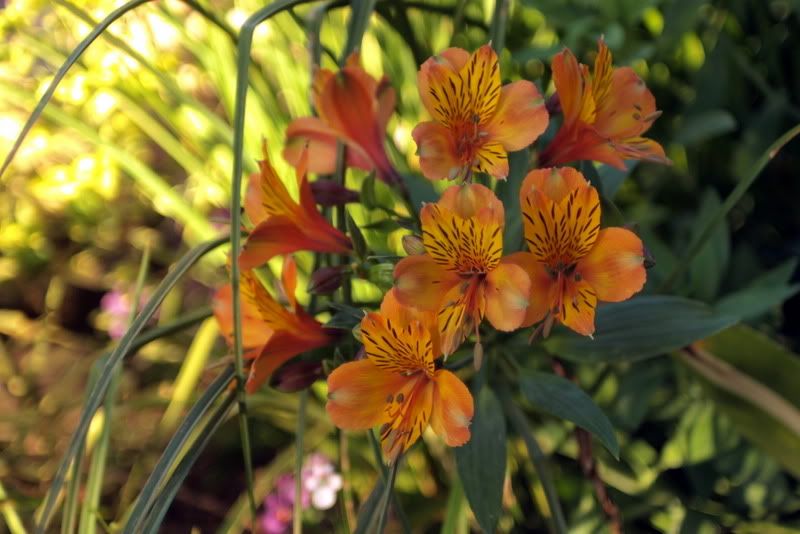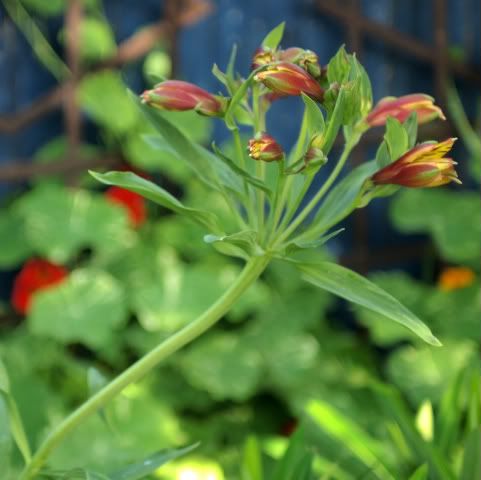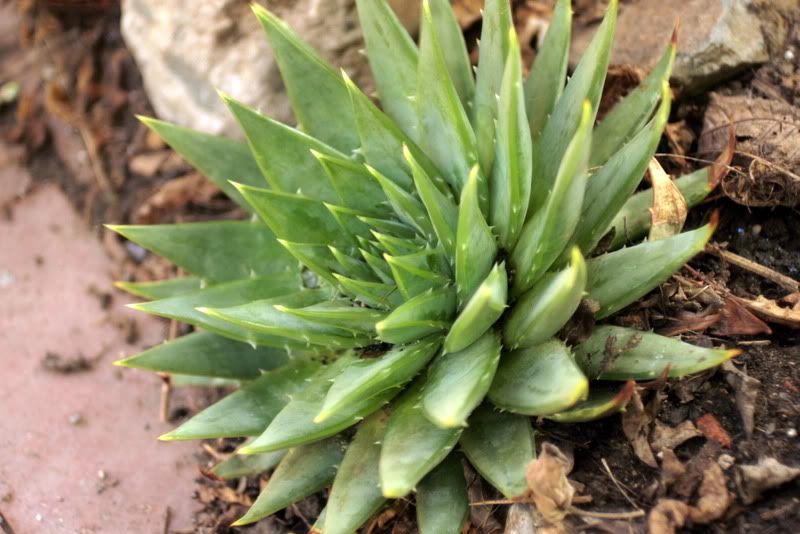You never know what creatures lurk in the tall grass.
(Obviously trying to camouflage those ears amongst the aloe.)
You never know what creatures lurk in the tall grass.
(Obviously trying to camouflage those ears amongst the aloe.)

The flowering stalks, when upright, graze my chin, and I’m 5’8.” This is a two-year-old clump, and it’s a good 5 feet across already.
These numbers do not jibe with catalogue descriptions of a reasonable height and spread of 2-3 feet.
To call a happily sited alstroemeria vigorous is already an understatement, so how to accurately describe the vigor of TTH?
Let’s just say that without a backhoe, there’s no turning back. Bred by George Hare, thankfully, this variety is sterile.
This year climbing nasturtiums in gold and burgundy are coinciding with TTH’s bloom. Nice.

To zone 8 and maybe 7 according to Plant Delights.
To see what’s in bloom this April in gardens around the world, visit May Dreams Gardens, for other Bloom Day posts, hosted by Carol. (Thanks, Carol!)
Here in Southern California, we’re well into spring, into wildflower season, about to begin garden tour season, so there’s lots in bloom.
These Scilla peruviana are just about finished blooming and the leycestria is bulking up.

The first flush of bloom on my climbing rose is nearly over.

Rose ‘Bouquet d’Or’
As I’ve written in posts like “Type G Personality,” it seems every summer has its folly. This year looks to be no different.
The chains are hung.
I’m using the word “folly” to mean a project of dubious merit, not in the gardenesque sense of anachronistic temples and grottoes popular in 19th century landscape gardens.
The chains are an attempt to forego using trellis to support the grapevine, which needs some help to make it up and then over the top of the pergola. I’ve moved out most of the pots and clutter under the pergola (yes, this is the cleared-out version), and intend to keep it more open. Handy and I had fish tacos and Peronis here last night. The little pot is a short-timer, to be potted with Agave ‘Kisho Kan’ and moved elsewhere. I’ve sworn to keep this table free of plants. The occasional cat may perch here, but when the mid-day summer sun hits the galvanized top, they’re going to feel about as comfortable as…well, as a cat on a hot tin roof. We mainly use the tables early in the morning and at the end of the day.
The grape, a dwarf Vitis vinifera ‘Purpurea,’ is grown for its leaves and not its fruit. I might have to thin the vine a bit to keep it confined to the lengths of chain.
The fatshedera was also grateful for a little support.
This is a good opportunity to introduce my partner in folly, who found the chains when I expressed interest in the idea, then lent a hand in hanging them. They were very heavy. He’d rather stay incognito, so for purposes of the blog, he’ll be known as “Handy.”
It was Handy’s idea to swag the chain horizontally, like a valance.
I’m not sure about the green paint of the pergola and the rusted chain, which kind of mixes the metaphor (upkeep and decay?) Not too sure about that swag either. But it’ll be interesting to find out how the grapevine and chain interact. Folly 2010 is launched.
Chinese Foxglove, Rehmannia elata, a robust, easy plant for Southern California, full sun/light shade, zones 9-10. About 2-3 feet in height.
Hated the mauvey color of the species, which sounds so petty, I know. This is the variety ‘Snow Glow.’ The spotted throats show up nicely against the creamy background.
I found this white selection at Flora Grubbs Gardens in San Francisco a few weeks ago.
Back in love with rehmannia.
Not a title to elicit amazement, you’re thinking. But I’ve never seen the fringe tree, Chionanthus retusus, in full bloom, branches and flowers weighted down by rain.
It can be tricky to get good views of this tree in bloom, planted as it is in the narrow east sideyard.
This morning the tree brought its blooms to me. Ducking under its drooping, rain-soaked canopy, stepping gingerly around snails.
Peering through to a garden framed with curtains and swags of snowy fringe.
In this winter rain/summer drought Mediterranean zone 10, this is very late in the season to get a half inch of rain. By now, it’s pretty much hose-dragging season.
I never sleep so sound as when rain has been forecast for overnight — and never hop out of bed so fast the next morning.
You can tell by the leaf litter that this guy is in the ground now, not in a pot anymore. In zone 10, planting in the ground is an option, since there’s no fear of frost damage.

But there are other enemies besides frost. This aloe is trickier than most other aloes I grow. Let’s further refine that to trickiest by a landslide.
The only real problem I’ve encountered with aloes is the inescapable fact that many of the beauties in the genus grow large and my garden is small. But Aloe polyphylla is exacting in its requirements. It wants a bit more moisture but perfect drainage. I moved the aloe out of a pot because you just can’t forget to water him, unlike most other succulents I grow which simply “pull in their horns” to deal with the occasional missed drink. In zone 10, Aloe polyphylla is sensitive to the cold, heavy soil of winter, and in my amended clay the entire stemless plant has been known to slough off like a cheap toupee by spring. I have planted this aloe at a slight angle, which seems to have been the key to getting it through this fairly rainy winter season. Shade from afternoon sun is also appreciated. That lovely celadon green of its leaves will tip burn in full sun.
So it’s off to a good start this spring. (With such touchy plants, it’s OK to consider bare survival a good start.) There remains the small problem of a failure to spiral. I’ve yet to have an Aloe polyphylla spiral for me. A possible theory I invented to ease the disappointment is that rampant tissue culture of this aloe is somehow at the root of the problem. As fun as it is to make up wild theories, the sober facts can be found on the website of the Cactus and Succulent Society of America, where it advises that “plants must reach a diameter of at least 8-12″ before they begin to spiral — and they may spiral either left or right — and amass about 90 leaves in order to support production of the large bloomstalk.” Mine currently measures 8 inches across, and I know I’ve had a nonspiraling plant well over a foot in diameter before, but no point getting cranky with the experts (or even a tiny bit jealous that they’re probably made absolutely dizzy by their spiral aloes.) And, honestly, even when it’s not spiraling, it is still a beautiful plant.
This used to be a hideously expensive aloe to buy because of its rarity in the wild, but the past few years I’ve been able to find inexpensive replacements now that propagation by tissue culture has been such a success. Here’s a photo from San Marcos Growers of the aloe in all its spiraling glory, just in case mine remains, for whatever reason, steadfast in its failure to spiral.
The cineraria I blogged about in early March has been blooming and gaining strength, topping now over 4 feet in height, coarse and sprawly. These two plants came from Annie’s Annuals, from the seed strain ‘Giovanni’s Select.’ One is a mid blue, the other purple. When the strong afternoon sun slants in, piercing the edge of the smoke tree’s canopy, the cineraria leaves just grazed by sunlight collapse in wilt but recover by twilight. Shade is a must. If I get any seedlings next year, I have to remember to pinch them back. No further sign of scale on the duranta. In these closeups, the cineraria resembles the diminutive brachycome daisies, but make no mistake, this is a formidable, out-sized daisy. One insistently wayward branch has been staked with rebar to keep it off the pathway.
I found this interesting take on the seasons in the 2/11/10 New York Review of Books, from Christian Carryl’s review of Robert Walser’s The Assistant. Carryl quotes this excerpt from the book:
“And the world, was it changing? No. A wintry image could superimpose itself upon the world of summer, winter would give way to spring, but the face of the earth remained the same. It put on masks and took them off again, it wrinkled and cleared its huge, beautiful brow, it smiled or looked angry, but remained always the same. It was a great lover of make-up, it painted its face now more brightly, now in paler hues, now it was glowing, now pallid, never quite what it had been before, constantly it was changing a little, and yet remained always vividly and restlessly the same.”
Mr. Walser, a Swiss writer unfamiliar to me before reading the review, spent the last 20 years of his life in a mental institution. Always comforted by long walks, one day he simply slipped out unnoticed into a snowstorm.
Another view of Western Hills, gunnera unfurling pondside, “vividly and restlessly the same.”
The paths of the garden at Western Hills, which I visited a couple weeks back, were crowded with the mauve blossoms of self-seeding honesty, the biennial Lunaria annua. Because it was ubiquitous, I took no photos but of course now sorely wished I had. MB Maher took this photo, which still doesn’t begin to convey the crush of mauve-flowering honesty round the bend of nearly every path.
I wished I had taken a photo of the carpets of lunaria because the color of the flower is so definitively mauve. And mauve, I just learned, was the first chemically created color. (No, I never took high school chemistry but was shunted into the girls-only ghetto of the clerical courses. And this was in the 1970s!)
At a time when the British Empire was being seriously inconvenienced by malaria, a boy of 18, William Henry Perkin, stumbled into this seminal link between chemistry and industry in 1856, when his experiment to discover a synthetic quinine went awry but inadvertently resulted in the first permanent chemical dye. Following Queen Victoria’s lead, the Victorians draped themselves in mauve.
Despite its historical significance, it would surprise me if anyone actively sought out this color to include in their gardens. For one thing, as colors go, it’s a bit of a non-starter. Does anyone really desire the color or just tolerate it for the sake of the useful plant on which it blooms? ( e.g. Erysimum ‘Bowle’s Mauve’)
But mauve also seems to carry the whiff of Victorian drawing rooms, aspidistras in copper pots on the entryway table alongside calling cards of visitors for tea later in the afternoon. In other words, mauve has been accused of being old-fashioned. But for next year, I’m thinking how well mauve sets off all the yellows and tender white flowers of spring. And there are dark-leaved and variegated varieties of lunaria worth searching seed catalogues for too. These are the kind of easy (some might say weedy but not me), billowy plants that give a garden body. A rather elusive concept, but the shorthand would be that which separates a garden from a landscape installation.
I found this April 5 photo, year unknown but within the last few years, of some lunaria blooming in my garden, to the right in the photo. This supposedly easy naturalizer for shade hasn’t found conditions here to its liking….yet.
Fine. California Poppy Day. But there’s a lot more Far Side of the World in the name Eschscholtzia.
No, Paul Bettany hasn’t played the role of Johann Friedrich von Eschscholtz, at least that I’m aware of. That’s Bettany portraying the physician and naturalist Dr. Stephen Maturin from the movie Master and Commander, positions Eschscholtz held on his two voyages. The stories are glancingly similar: science, adventure, and strong friendships sailing aboard a tall ship to The Far Side of the World, before radar, satellites, or GPS, when there was still world left to be explored.
Because April 6 is California Poppy Day, I spent a few minutes searching for the great deeds of the naturalist Eschscholtz (an interminable length of time in the era post-Internet, but imagine how time passed on those sailing voyages!) but there was little to be found. I was certain he bore a close resemblance to Bettany’s sexy naturalist in Master and Commander. As it turns out, not really, but still handsome in his own way. He was only 37 when he died but had traveled the world by sail twice, 1815 to 1818 and 1823 to 1826. We’re talking circumnavigation.
Eschscholtz sailed on Otto von Kotzebue’s scientific expedition to California and the greater Pacific in 1815 to 1818 aboard the Russian ship Rurik with a crew of 27 men, one of whom was his friend Adelbert von Chamisso, the German botanist. It was Chamisso, who was also a poet, who named our state flower after his friend. So the mouthful of mostly consonants that is the state flower of California has this awkward name because of a friend’s affection. All is forgiven.
Eschscholtzia californica, our golden poppy.
Unlike the friendship of Dr. Stephen Maturin, scientist, and Jack Aubrey, commander, detailed in the movie from Patrick O’Brian’s novel, the friendship of Eschscholtz and Chamisso differed in that they were both scientists. Eschscholtz did name a lupine after his friend, Lupinus chamissonis.
“”…It is during the months of spring that this queen of California flowers holds her especial court….It is a true poppy, a member of the same drowsy family with the immemorial flower of sleep and the Shirleys of our garden. Our Spanish people have several names for it, as ‘torosa’ and ‘toronja’….and the name it shares with other poppies, ‘dormidera,’ the sleepy one, because of its habit of closing its petals at the approach of evening, as though dropping off to sleep…”
– Charles Francis Saunders, With the Flowers and Trees of California, 1914″
Apparently, this poppy beat out another member of the poppy family, Romneya coulteri, or the Matilija Poppy, for the title of state flower. Romneya got zero votes. Personally, I’d have been hard-pressed to choose between the two.
I’m reprising a 2/23/10 photo of a local wildflower meadow because I have no California poppies to show from my garden. I planted two ‘Apricot Chiffon’ varieties of eschscholtzia, one of which died soon after planting and the other of which produced far more leaves than flowers, no doubt a consequence of soil too rich for these wildflowers.
I hope all this history hasn’t caused anyone to become dormidera (the sleepy one).